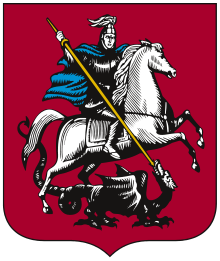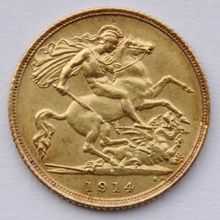Saint George and the Dragon
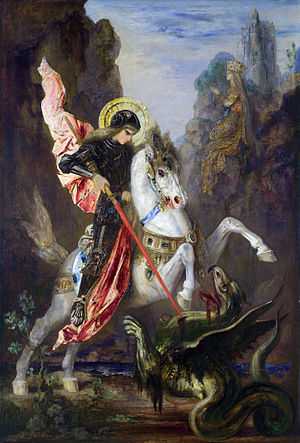

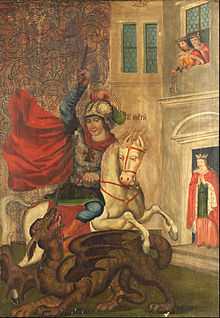
The episode Saint George and the Dragon appended to the hagiography of Saint George was Eastern in origin,[1][2] brought back with the Crusaders and retold with the courtly appurtenances belonging to the genre of Romance. The earliest known depictions of the motif are from tenth- or eleventh-century Cappadocia[3] and eleventh-century Georgia;[4] previously, in the iconography of Eastern Orthodoxy, George had been depicted as a soldier since at least the seventh century. The earliest known surviving narrative of the dragon episode is an eleventh-century Georgian text.[5]
The dragon motif was first combined with the already standardised Passio Georgii in Vincent of Beauvais' encyclopedic Speculum Historiale, and then Jacobus de Voragine's Golden Legend (ca 1260) guaranteed its popularity in the later Middle Ages as a literary and pictorial subject.[6] The legend gradually became part of the Christian traditions relating to Saint George and was used in many festivals thereafter.[7]
Legends
.jpg)
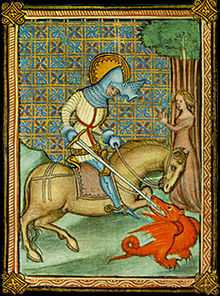
According to the Golden Legend, the narrative episode of Saint George and the Dragon took place somewhere he called "Silene", in Libya; the Golden Legend is the first to place this story in Libya as a sufficiently exotic locale, where a dragon might be found. In the tenth-century Georgian narrative, the place is the fictional city of Lasia, and the idolatrous emperor who rules the city is called Selinus.[8]
The town had a pond, as large as a lake, where a plague-bearing dragon dwelt that poisoned all the countryside. To appease the dragon, the people of Silene used to feed it two sheep every day, and when the sheep failed, they fed it their children, chosen by lottery. It happened that the lot fell on the king's daughter, who is called Sabra in some versions of the story.[9] The king, distraught with grief, told the people they could have all his gold and silver and half of his kingdom if his daughter were spared; the people refused. The daughter was sent out to the lake, dressed as a bride, to be fed to the dragon.[8]
Saint George by chance rode past the lake. The princess, trembling, sought to send him away, but George vowed to remain. The dragon reared out of the lake while they were conversing. Saint George fortified himself with the Sign of the Cross,[10] charged it on horseback with his lance, and gave it a grievous wound. He then called to the princess to throw him her girdle, and he put it around the dragon's neck. When she did so, the dragon followed the girl like a meek beast on a leash.
The princess and Saint George led the dragon back to the city of Silene, where it terrified the people at its approach. But Saint George called out to them, saying that if they consented to become Christians and be baptised, he would slay the dragon before them. The king and the people of Silene converted to Christianity, George slew the dragon, and the body was carted out of the city on four ox-carts. "Fifteen thousand men baptized, without women and children." On the site where the dragon died, the king built a church to the Blessed Virgin Mary and Saint George, and from its altar a spring arose whose waters cured all disease.[11]
Traditionally, the sword[12] with which St. George slew the dragon was called Ascalon, a name recalling the city of Ashkelon, Israel. From this tradition, the name Ascalon was used by Winston Churchill for his personal aircraft during World War II (records at Bletchley Park), since St. George is the Patron Saint of England.
In a later version of the legend, St. George travelled for many months by land and sea until he came to Libya. Here he met a poor hermit who told him that everyone in that land was in great distress, for a dragon had long ravaged the country.
'Every day,' said the old man, 'he demands the sacrifice of a beautiful maiden and now all the young girls have been killed. The king's daughter alone remains, and unless we can find a knight who can slay the dragon she will be sacrificed tomorrow. The king of Egypt will give his daughter in marriage to the champion who overcomes this terrible monster.'
When St. George heard this story, he was determined to try and save the princess, so he rested that night in the hermit's hut, and at daybreak set out to the valley where the dragon lived. When he drew near he saw a little procession of women, headed by a beautiful girl dressed in pure Arabian silk. The princess Sabra was being led by her attendants to the place of death. The knight spurred his horse and overtook the ladies. He comforted them with brave words and persuaded the princess to return to the palace. Then he entered the valley.
As soon as the dragon saw him it rushed from its cave, roaring with a sound louder than thunder. Its head was immense and its tail fifty feet long. But St. George was not afraid. He struck the monster with his spear, hoping he would wound it.
The dragon's scales were so hard that the spear broke into a thousand pieces. and St. George fell from his horse. Fortunately he rolled under an enchanted orange tree against which poison could not prevail, so that the venomous dragon was unable to hurt him. Within a few minutes he had recovered his strength and was able to fight again.
He smote the beast with his sword, but the dragon poured poison on him and his armour split in two. Once more he refreshed himself from the orange tree and then, with his sword in his hand, he rushed at the dragon and pierced it under the wing where there were no scales, so that it fell dead at his feet.
Treatment by artists
- Paintings
- Paolo Uccello, Saint George and the Dragon, c. 1470. National Gallery, London.
- Giovanni Bellini, Saint George Fighting the Dragon, c. 1471. Pesaro altarpiece.[13]
- Raphael (Raffaello Santi), St. George, 1504. Oil on wood. Louvre, Paris, France.
- Raphael (Raffaello Santi), St. George and the Dragon, 1504–1506. Oil on wood. National Gallery of Art, Washington, D.C., United States
- Tintoretto (Jacopo Robusti), Saint George and the Dragon, 1555.[14]
- Peter Paul Rubens, Saint George and the Dragon, 1620.
- Edward Burne-Jones, St. George and the Dragon, 1866.[15]
- Gustave Moreau, St. George and the Dragon, c. 1870. Oil on canvas. The National Gallery, London.
- Briton Rivière, St. George and the Dragon, c. 1914.
- Uroš Predić, St George Killing the Dragon, 1930
- Sculptures
- Bernt Notke, wood, Storkyrkan in Stockholm, ca. 1484–1489.[16]
- Salvador Dalí, Saint George and the Dragon, Open Air Museum in Cosenza, 1947
- Landmark Loews Movie Palace Statue, Saint George and the dragon at The Landmark Loews Movie Palace in Jersey City, NJ, US. 2010.[17]
- The sculptures which form part of the clock of Liberty's store in Regent Street, London (19th century).[18]
- Mosaic
- Edward Poynter, Saint George for England, 1869. Central Lobby in the Palace of Westminster.
- Engravings
- Benedetto Pistrucci, engraving for coin dies, 1817.
- Shakespeare
William Shakespeare refers to St. George and the Dragon in Richard III; act v, also in King Lear; act I.
| “ | Advance our standards, set upon our foes Our ancient world of courage fair St. George Inspire us with the spleen of fiery dragons..... Richard III. act v, sc.3. |
” |
- Other
- Edward Elgar, The Banner of St George: a ballad for chorus and orchestra, words by Shapcott Wensley, 1879.
- A 17th-century broadside ballad paid homage to the feat of George's dragon slaying. Titled "St. George and the Dragon", the ballad considers the importance of St. George in relation to other heroes of epic and Romance, ultimately concluding that all other heroes and figures of epic or romance pale in comparison to the feats of George.[19]
Coats of arms
- Croatia: Kaštel Sućurac.
- Denmark: Holstebro.
- Republic of Georgia.
- Germany: Bürgel, Hattingen, Mansfeld, St. Georgen im Schwarzwald, Schwarzenberg.
- Hungary: Pécsvárad.
- Italy: Reggio Calabria.
- Lithuania: Marijampolė, Prienai, Varniai.
- Netherlands: Terborg.
- Poland: Brzeg Dolny, Milicz.
- Romania: Suceava.
- Russia: Moscow.
- Serbia: Srpski Krstur.
- Slovakia: Svätý Jur.
- Switzerland: Castiel, Kaltbrunn, Ruschein, Schlans, Stein am Rhein, Waltensburg/Vuorz.
- Ukraine: Kiev Oblast, Liuboml, Nizhyn, Taikury, Volodymyr-Volynskyi.
Contemporary retelling
- The 1898 Dream Days by Kenneth Grahame includes a chapter entitled The Reluctant Dragon, in which an elderly St. George and a benign dragon stage a mock battle to satisfy the townsfolk and get the dragon introduced into society. Later made into a film by Walt Disney Productions, and set to music by John Rutter as a children's operetta.
- In 1935 Stanley Holloway recorded a humorous retelling of the tale as St. George and the Dragon written by Weston and Lee.
- The Dragon Knight, a series of books by Gordon R. Dickson, adopted this story as a past event into its canon, significant in that dragons had since referred to humans as 'georges.' The story of St. George and the Dragon is referred to on occasion, but never told. The first book in the series, The Dragon and the George, is a retelling of a previous short story by the same author, "St. Dragon and the George".
- In the 1950s, Stan Freberg and Daws Butler wrote and performed St. George and the Dragon-Net (a spoof of the tale and of Dragnet) for Freberg's radio show. The story's recording became the first comedy album to sell over 1 million copies.
- The 1962 film The Magic Sword is loosely based on the legend.
- The 1968 children's book The Iron Man, by Ted Hughes, is a contemporary re-telling of the myth in which nature (the dragon, named the 'space-bat-angel-dragon' in the book) and man eventually work together symbiotically, creating harmony on Earth after the eponymous Iron Man defeats the beast in a contest of endurance.
- A 1975 episode of "Space: 1999" titled "Dragon's Domain" made reference to the legend of St. George and the Dragon. A crewman from the space station heroically kills a dragon-like creature after it has consumed other astronauts. The main character played by Barbara Bain eventually concludes that the crewman's story will create new mythology similar to the legend of St. George.
- The 1981 Paramount Pictures/Disney film Dragonslayer was loosely based on the tale.[20]
- EC Comics published a comic called "By George!!" in Weird Fantasy #15. The story revealed that the 'dragon' was in fact a lost, misunderstood alien child who did not mean any harm.
- Margaret Hodges retold the legend in a 1984 children's book (Saint George and the Dragon) with Caldecott Medal-winning illustrations by Trina Schart Hyman.
- American artist Butt Johnson uses the theme in a drawing entitled "Mario, Patron Saint of Brooklyn" portraying characters from the video game Super Mario Bros., and featuring Mario in the role of Saint George – slaying the "dragon" (King Koopa).
- The poem "Fairy Tale" by Yury Zhivago–the main character from Boris Pasternak's novel "Doctor Zhivago"–relates a modified account of this legend; Yury's poem differs in that it is nonreligious and makes no mention of the village.
- In Elizabeth Kostova's The Historian,[21] Saint George is chronicled as being the saint who killed Vlad Tepesh[22] (also known as Dracula, which means "son of the dragon" or "son of the devil").
- In Graham McNeill's Horus Heresy novel Mechanicum, Book 9 of the Horus Heresy book series, the story is retold and St. George is revealed to be the future Emperor of Mankind.[23]
- The animated series Ben 10: Ultimate Alien has Sir George, a thousand year old immortal who slays an extra-dimensional dragon called Diagon.
- The Japanese Light Novel High School DxD Main Character Isse Hyoudou was gifted The Holy Sword of Saint George Ascalon.
- In 2004, a made-for-TV movie was released, alternatively titled Dragon Sword or George and the Dragon, starring James Purefoy and Piper Perabo.
- One of the stories in the AvP: Annual anthology comic book reveals that the dragon killed by St. George was actually an Alien, as the result of a crashed Predator spaceship.
- The story was referenced on the cover of the 1983 album Confrontation (Bob Marley & The Wailers album) which shows a recently deceased Bob Marley in the place of Saint George.
Alternative legends
The village of Wormingford in Essex, England also lays claim to the George and the Dragon legend. A dragon, now believed to have been a crocodile that escaped from Richard I, was slain in the River Stour. There are differing accounts, including different dragon slayers, however one popular account tells how Sir George Marney (of Layer de la Haye) killed the dragon with his lance. The church in Wormingford (which is dedicated to St Andrew) has a stained glass window depicting this scene.[24][25]
One version of the tale tells St. George as losing the battle with the dragon early on in the encounter. St. George retreats, and wanders down to the river. He prays over his challenges, and removes his armor to melt it down. He takes the melted metal and forges it into a metal box. He places his fears, doubts, and lack of faith inside the box, and goes out to face the dragon again, without armor. St. George instantly slays the dragon.
Gallery
|
See also
- Saint George
- Saint George: Devotions, traditions and prayers
- Princess and dragon
- Ducasse de Mons
Notes
- ↑ 'To the Glory of St George' in: Ingersoll, Ernest, et al., (2013). The Illustrated Book of Dragons and Dragon Lore. Chiang Mai: Cognoscenti Books. ASIN B00D959PJ0
- ↑ Robertson, The Medieval Saints' Lives (pp 51–52) suggested that the dragon motif was transferred to the George legend from that of his father fellow soldier saint, Saint Theodore Tiro. The Roman Catholic writer Alban Butler (Lives of the Saints) was at pains to credit the motif as a late addition: "It should be noted, however, that the story of the dragon, though given so much prominence, was a later accretion, of which we have no sure traces before the twelfth century. This puts out of court the attempts made by many folklorists to present St. George as no more than a Christianized survival of pagan mythology."
- ↑ Walter 2003:128, noted by British Museum Russian Icon "The Miracle of St George and the Dragon / Black George".
- ↑ Christopher Walter, The Warrior Saints in Byzantine Art and Tradition 2003:141, notes the earliest datable image, at Pavnisi, Georgia (1154–58)
- ↑ Patriarchal Library, Jerusalem, codex 2, according to Christopher Walter, The Warrior Saints in Byzantine Art and Tradition 2003:140; Walter quotes the text at length, from a Russian translation.
- ↑ Margaret Aston, Faith and Fire Continuum Publishing, 1993 ISBN 1-85285-073-6 page 272
- ↑ Christian Roy, 2005, Traditional Festivals ISBN 978-1-57607-089-5 page 408; Dorothy Spicer, Festivals of Western Europe, (BiblioBazaar), 2008 ISBN 1-4375-2015-4, page 67
- ↑ 8.0 8.1 Quoted in Walter 2003:141.
- ↑ http://www.mainlesson.com/display.php?author=langm&book=saints&story=patron
- ↑ In the earliest, Georgian version where the dragon is more clearly a representation of paganism, or at least of infernal power, the sign of the Cross itself was sufficient to defeat the dragon.
- ↑ Thus Jacobus de Voragine, in William Caxton's translation (On-line text).
- ↑ Ascalon, Askalon (Seven Champions); Askelon (Percy's ballads)
- ↑
- ↑
- ↑
- ↑ Nordisk familjebok. 1914.
- ↑
- ↑ The Liberty Clock waymarking.com.
- ↑ Ballad full text
- ↑ No Land is an Urland- The Creation of the World of Dragonslayer by Danny Fingeroth from Dragonslayer- The Official Marvel Comics Adaptation of the Spectacular Paramount/Disney Motion Picture!, Marvel Super Special Vol.1, No. 20, published by Marvel Comics Group, 1981
- ↑ The Historian
- ↑ Vlad tepes
- ↑ McNeill, Graham (2008). Mechanicum: war comes to Mars (MASS MARKET PAPERBACK) (print). Horus Heresy [book series] 9. Cover art & illustration by Neil Roberts; map by Adrian Wood (1st UK ed.). Nottingham, UK: Black Library. pp. 212–215, 360–364. ISBN 978-1-84416-664-0.
- ↑ http://www.bures-online.co.uk/dragon/worm.htm
- ↑ dedhamvalesociety.org.uk
References
- Loomis, C. Grant, 1949. White Magic, An Introduction to the Folklore of Christian Legend (Cambridge: Medieval Society of America)
- Whatley, E. Gordon, editor, with Anne B. Thompson and Robert K. Upchurch, 2004. St. George and the Dragon in the South English Legendary (East Midland Revision, c. 1400) Originally published in Saints' Lives in Middle English Collections (on-line text: Introduction).
- Catholic Encyclopedia, "Saint George"
- (Kalamazoo, Michigan: Medieval Institute Publications) (On-line Introduction)
External links
| Wikimedia Commons has media related to Saint George and the Dragon. |
- Saint George Legend explained in Javascript by Tomás Corral
- Saint George church in Dolinka (Hungarian: Inám)
- St George and the Dragon Events and Ideas – Official Website for Tourism in England
- St George Unofficial Bank Holiday: St. George and the Dragon, free illustrated book based on 'The Seven Champions' by Richard Johnson (1596)
- St George's Bake and Brew
- St. George Killing the Dragon: aromatic icon
| ||||||||||


